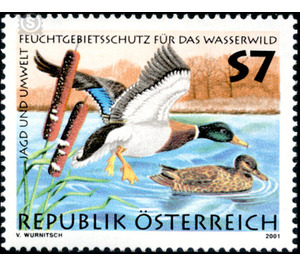Hunting and environment - Austria / II. Republic of Austria 2001 - 7 Shilling
Theme: Animals
| Country | Austria / II. Republic of Austria |
| Issue Date | 2001 |
| Face Value | 7.00 |
| Printing Type | Photogravure |
| Stamp Type | Commemorative |
| Item Type | Stamp |
| Chronological Issue Number | 1679 |
| Chronological Chapter | OOS-OE2 |
| SID | 606299 |
| In 62 Wishlists | |
In recent decades - less in the very last few years - many wetlands have been drained and farmed to increase agricultural yields. Dedicated hunters are now working together with some interested landowners not only to preserve existing wetlands or to improve through ponds and bank woodland, but also create new wetlands and water surfaces. Of course, the benefits of this are many animals, from frogs to many species of ducks to the rarest waterfowl, such as night herons and cormorants and others. The mallards that we find in the parks and count to the swimming, seeking their food in the shallow water and have thereby the "head in the water, the tail in the height". The divers get their food from several meters depth. The Hunting Association uses large funds to protect areas worthy of protection. As an example, the project called Grabensee at Marchegg, where the largest duck colony, stork and heron colonies are. Marchegg has the only Central European breeding colony where storks still nest on trees according to their original behavior.


